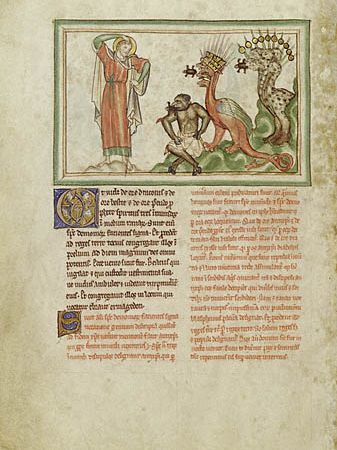 | Some of the most interesting and artistic manuscripts of the Middle Ages were the famous bestiaries, regarded with both awe and fascination, as their pages were literally swarmed with fantastic and mythological beasts of all kind. The usual animals played a key-role in the medieval economy, but at the same time were imagined as visual symbols. From there to the creation of mythological beasts, that existed or had existed in ancient times or faraway, utopian lands, was just a step. And this step was made when bestiaries appeared, impressive and colourful manuscripts, that put together fantastic representations of ordinary animals with imaginary and legendary ones, such as the dragons or the sea monsters. |
The bestiaries were, following religious texts, the most popular writings in the Middle Ages. Although expenssive for the most, their contents came into the public as word to mouth stories or cheap reproductions.
The J. Paul Getty Center in Los Angeles, USA, is hosting until the 29th of July 2007 one of the most important exhibitions dedicated to the world of the medieval beasts, as represented in the bestiaries of that time. The curators have managed to select some of the best examples of the genre, with vivid, colour rich illustrations, depicting imaginary animals, zodiacal beasts, terrifying monsters. It is one of the few events dedicated to a rich and fascinating form of art that played an important role in the fashioning of medieval thought and legends.
 | Among the beasts pictured, the most impressive, horible and known was without a doubt the dragon, seen as the most powerful creature, who usually lurked into hiding, often guarding vast amounts of treasure. Not only fantastic animals found their way into the pages of bestiaries, but also utilitary animals or those used for clashes, such as the war horses. These are richly present in manuscripts, as they were the most important asset for a warrior. A good warhorse could cost over 800 times the price of a horse used for agriculture, and the representations show him as a powerful beast, a weapon in it's own. |
This fascination for animals, both real and immaginary, was in a way a tribute to the Christian belief that all creatures are symbols of the divine plan, so even the most horrific had something to admire. Animals and beasts found their way also of the coat of arms, as symbols of the owners virtues and qualities. Simon de Varie, for example, a French knight and treasury official, used the image of the greyhound on the coat of arms, in order to show his faith and loyalty for the king.

In the time of the Middle Ages, as most of the world outside Europe was a mistery and source of fantastic legends, myths and strange representantions were usual. One could here about the huge animals, with a long nose and great power, which were called elephants or about the griffins, with their lion body, complemented with the head and wings of an eagle. The artists and storytellers let their imagination run wild in presenting these fabulous beasts.
Also, the beasts from Greek and Roman mythology were hugely popular, and it was said that they still existend, in a place unknown.

One of the best stories, enriched with numerous drawings, was the Apocalypse from the Bible, were the beasts were cruel, terrifying and acting as the instrument of God's wrath or as servants of the Antichrist.
Photo : getty.edu
2007-07-09

































